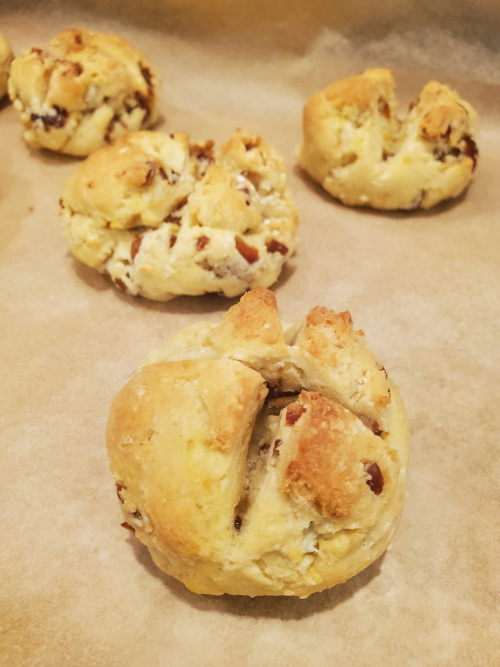Hot Cross Buns
☙ ❧
Posted in Recipes • March 30, 2024

Paganism and Christianity share more traditions with each other than the more fanatic members of either faith might like to admit. Early Christians who had converted from ancient paganism often brought their old customs with them into their new faith, adapting their meaning to this new context. Likewise, when paganism was revived in the 19th and 20th centuries, many converts from Christianity did the same thing in the opposite direction. This back-and-forth dynamic has led to many customs finding their way into both religions, and consequentially to a lot of confusion and arguments over who stole what from whom. But personally, I don't think we need to assume that anyone stole anything; it strikes me more as a case of honest syncretism. Conversion to a new religion doesn't have to mean giving up all of one's old and beloved traditions, and people will often find ways to invest familiar customs with a new spiritual significance. I think this is something to be embraced, for Pagans and Christians alike.
This syncretic relationship is especially on display at this time of year. On the Spring Equinox, many modern Pagans celebrate a festival called Ostara, whose associated symbols include rabbits or hares and painted eggs. Shortly afterwards, Christians celebrate the similarly-named holiday Easter, which shares much of the same symbolism. The names of both holidays are of pagan origin, being derived from the name of the Germanic dawn goddess Eostre, but the association with bunnies comes from Christianity, in which the hare is a traditional symbol of the Virgin Mary, and as far as I know, the jury's still out on who first came up with the painted eggs.
Hot cross buns are another tradition that's shared between both holidays. The cross is best known today as a Christian symbol, but it has significance to Pagans as well. To Christians, of course, the cross represents Jesus's sacrifice in the Crucifixion. To Pagans, an equal-armed cross (often inscribed in a circle) is a symbol of wholeness and nature's cycles, representing such fourfold divisions of the world as the four seasons, four cardinal directions, four quarters of the moon, and four states of matter. And regardless of your religion, I think anyone can appreciate a tasty bun.
My recipe for hot cross buns is loosely adapted from this one by Danielle Proholm Olson (linked here via the Internet Archive). I'm including that link to give credit where it's due, but I do so hesitantly because, fond though I am of that author's recipes, I've unfortunately come across some things she's written elsewhere that strongly suggest that she's a TERF, or at least disconcertingly TERF-adjacent. If you like you can consider this the new-and-improved, trans-friendly version of this recipe. And for whatever it's worth, Eostre has appeared to me in a transfeminine form when I've done devotional meditations for her, and Jesus was rather famously genderqueer (at least if the medieval mystics are to be believed), so the relevant deities seem to be in our corner. So go forth, my friends, and be queer, eat hot cross buns, and rejoice in the coming of the Spring!
Ingredients:
- 2 ¼ teaspoon yeast
- ¼ cup granulated sugar
- ⅓ cup warm water, plus more if needed
- 2 ¾ cups gluten-free all-purpose flour
- ½ cup warm coconut milk
- 2 tablespoon melted coconut oil
- 1 tablespoon honey
- 1 egg
- About 1 cup chopped dates (I didn't measure them precisely)
- About 10 saffron threads, or equivalent amount saffron powder
- 1 tsp salt
- Ginger
- Nutmeg
- Cardamom
Procedure:
Combine the yeast, sugar, and warm water in a bowl and set aside to let the yeast do its thing.
In a separate bowl, combine the flour, salt, and spices. If you are using saffron threads, crush them in a mortar and pestle before adding them. As usual, I took the "measure it with your heart" approach to the spices, so I don't have precise measurements there, but a quarter to a half teaspoon of each should do the trick.
Once the yeast mixture is getting bubbly, add it to the bowl with the flour. Also add the coconut milk, coconut oil, honey, and egg. Vigorously stir the whole thing together until a thick, homogeneous dough forms. If the dough is too dry, add a little more water, but be careful to only add it a little at a time — you don't want it to get too runny.
Mix the chopped dates into the dough. Cover the bowl of dough with a tea towel and let it rise for about an hour, until it has roughly doubled in size.
Divide the dough into eight equal portions and roll each portion into a small ball. Place the balls of dough on a baking sheet lined with parchment paper, cover them again, and let them rise for another half hour or so.
Preheat your oven to 350 °F. With a kitchen knife, score a cross on each ball of dough.
Bake for about 30 minutes, until the buns are golden brown and a knife or toothpick inserted comes out clean. Let the buns cool just enough to be edible, but not too much, and serve them forth while they're still warm. Enjoy!